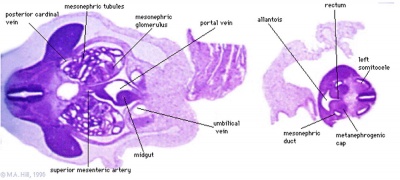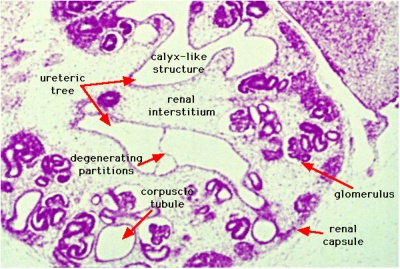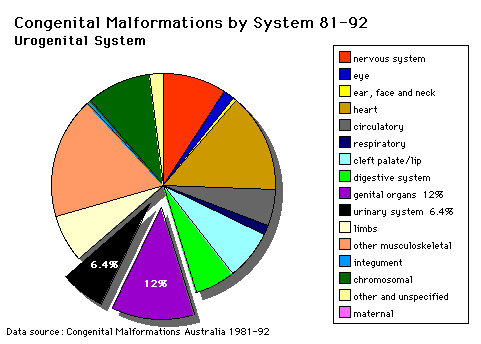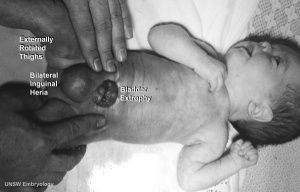Talk:Lecture - Renal Development: Difference between revisions
No edit summary |
mNo edit summary |
||
| (9 intermediate revisions by 2 users not shown) | |||
| Line 1: | Line 1: | ||
= | ==2015== | ||
{| class="wikitable mw-collapsible mw-collapsed" | |||
! ECHO360 Recording | |||
{| | |||
|- | |- | ||
| [[File:ECHO360_icon.gif|right|link=https://lectures.unsw.edu.au/ess/portal/section/691ba9a0-7c35-4ad2-8fd0-846db7771557]] | |||
Links only work with currently enrolled UNSW students. | |||
|} | |} | ||
[http://lectopia.telt.unsw.edu.au/lectopia/lectopia.lasso?ut=153&id=110466 2011 Lecture 15 Audio] | |||
==Urinary System Development== | |||
* The adult kidneys (the metanephroi) form from day 35, from a portion of the intermediate mesoderm called the metanephric blastema (or metanephric mesenchyme). | |||
* They are induced to form by the ureteric buds, outgrowths from the end of the mesonephric ducts, which come into contact with the metanephric blastema. | |||
* Upon contact, they begin to lengthen and bifurcate rapidly in the metanephric blastema – these branches differentiate into the collecting ducts. | |||
* Both the ureteric buds and the metanephric blastema begin to differentiate; interestingly each induces differentiation in the other structure. | |||
**The ureteric bud is induced by the metanephric blastema to form the collecting tubules, renal pelvis and ureters. | |||
** The metanephric blastema is induced to form the nephrons. | |||
* development occurs laterally symmetrical (left right) | * development occurs laterally symmetrical (left right) | ||
| Line 107: | Line 27: | ||
* eventually making contact with the '''cloaca''' | * eventually making contact with the '''cloaca''' | ||
==Mesonephric Duct== | ===Kidney and Mesonephric Duct=== | ||
{| | |||
| | |||
<wikiflv width="356" height="500" autoplay="true" position="left">Urogenital_sinus_001.flv|File:Urogenital_sinus_001 icon.jpg</wikiflv> | |||
| '''First observe the development of the intermediate mesoderm.''' | |||
* This looped animation shows the 3 stages of kidney development (pink) in relation to the hindgut region between Week 4 and 5. | |||
* The earliest stage of kidney development begins up near the pharyngeal arches as the '''pronephros''' (cervical nephrotomes) which quickly degenerate, beside these the mesonephric duct begins to form (purple). | |||
* The next stage is the extensive '''mesonephros''' (red) which extends down towards the developing hindgut region (yellow). Associated with the mesonephros is the '''mesonephric duct''' (purple). | |||
* The mesonephric duct gives off a lateral branch forming the '''ureteric bud'''. | |||
* The ureteric bud interacts with the surrounding mesenchyme to begin the final stage in renal development, formation of the metanephros (pink) which will form the adult kidney. | |||
* | '''Next observe the changes occuring in the hindgut region (yellow) ending in the embryo at the cloaca.''' | ||
* | * The posterior portion (nearest the mesonephros) remains as the gastrointestinal tract hindgut forming the '''rectum'''. | ||
* | * The anterior portion (extends into the connecting stalk as the '''allantois''') | ||
** | ** becomes separated from the hindgut and forms the '''urogenital sinus''', primordia of the urinary bladder. | ||
** The two '''mesonephric ducts''' initially open into the urogenital sinus. | |||
|} | |||
===Human Stages=== | |||
{| | |||
| [[File:Stage 13 image 081.jpg|400px]] | |||
| [[File:Stage_22_image_188.jpg|400px]] | |||
|- | |||
| Embryo Stage 13 mesonephros (week 5) | |||
| Embryo Stage 22 metanephros (week 8) | |||
|} | |||
[[File:Stage_22_image_189.jpg|400px]] | |||
* | ===Kidney Nephron=== | ||
* | '''Nephrogenesis''' is the process of generating new nephrons (continues to GA Week 36). | ||
* 200,000 - 2,700,000. | |||
* nephron number correlates with kidney volume. | |||
== | {| border='0px' | ||
|- | |||
| <wikiflv width="320" height="230" autoplay="true" position="left">Renal_001.flv|File:Renal_001 icon.jpg</wikiflv> | |||
[[Quicktime Development Animation - Renal|Quicktime version]] | |||
| valign="top" |'''Early Renal Development''' | |||
This animation shows the process of early renal (kidney) development. | |||
'''Legend''' | |||
= | * <font color=purple>'''Uteric Bud'''</font> - developing ureter, pelvis, calyces, collecting ducts | ||
* <font color=salmon>'''Metanephric Blastema''' (intermediate mesoderm)</font> - developing glomeruli, capsule, nephron tubules | |||
* | |||
'''Sequence''' | |||
* | * '''cyst''' invaginates twice to form a '''comma''' | ||
* then a''' S-shaped body''' one invagination site later becomes the '''glomerular cleft''' | |||
* At about this time blood vessel progenitors invade cleft to begin construction of vascular component of '''glomerulus''' | |||
* Tubule maturation specialised transporting segments of nephron differentiate complex of convoluted tubules is created | |||
|- | |- | ||
|} | |} | ||
===Development of the Urethra=== | |||
* | * Further development of the urinary system varies depending on the sex of the embryo. | ||
* forms | * Males - the pelvic urethra forms the membranous urethra, the prostatic urethra and penile urethra. (The sex of the above animation and sections is male) | ||
* | * Females - the pelvic urethra forms the membranous urethra and the vestibule of the vagina. | ||
==Ten Most Frequently Reported Birth Anomalies== | |||
= | Based upon statistics from the Victorian Perinatal Data Collection Unit in Victoria (Australia) between 2003-2004. | ||
[[File: | {| | ||
[[File: | |- | ||
| width=100px| [[File:Hypospadia_classifications.jpg|100px|Hypospadia]] | |||
# | | '''Hypospadias''' (More? [[Development Animation - Genital Male External]] | [[Genital_System_-_Abnormalities#Hypospadia|Genital Abnormalities - Hypospadia]]) | ||
# | |-bgcolor="F5FAFF" | ||
# | | [[File:Hydronephrosis.jpg|100px|Obstructive Defect of the Renal Pelvis]] | ||
# | | '''Obstructive Defects of the Renal Pelvis''' (obstructive defects of the renal pelvis, uteropelvic junction obstruction, pelvo-uterero junction obstruction) Term describing a developmental renal abnormality due to partial or complete blockage of the drainage of the kidney pelvis requiring surgical correction. The blockage can also have several causes including: unusual [[U#ureter|ureter]] twisting or bending, [[U#ureter|ureter]] compression by a blood vessel, malformations of the muscular wall. The blockage leads to an accumulation of urine in the affected region, with several potential effects: [[N#nephron|nephron]] damage from compression (hydronephrosis); decreased urine output leading to lack of amniotic fluid ([[O#oligohydramnios|oligohydramnios]]); respiratory development effects due to the lack of [[A#amniotic fluid|amniotic fluid]]. | ||
* The most common type of obstruction is at the ureteropelvic junction (UPJ), between the junction of the ureter and the kidney. | |||
* | * Blockage lower as the ureter enters the bladder, the ureterovesicular junction (UVJ), usually involves only one kidney and the back flow enlarges the affected ureter ([[M#megaureter|megaureter]]). | ||
(More? [[Renal System - Abnormalities]] | [[Renal System Development]]) | |||
|- | |||
| [[File:Ventricular_Septal_Defect.jpg|80px|Ventricular Septal Defect]] | |||
| '''Ventricular Septal Defect''' (More? [[Cardiovascular_System_-_Abnormalities#Ventricular_Septal_Defect|Cardiovascular Abnormalities - Ventricular Septal Defect]]) | |||
[[File:Basic_Heart_Development_Timeline.jpg|600px]] | |||
Heart Development Timeline (see [[Basic Cardiac Embryology]]) | |||
|- | |||
File: | | [[File:Congenital_dislocation_hip.jpg|100px|Congenital dislocation hip]] | ||
| '''Congenital Dislocated Hip''' (More? [[Musculoskeletal_System_-_Abnormalities#Developmental_Dysplasia_of_the_Hip|Musculoskelal Abnormalities - Congenital Dislocation of the Hip (CDH)]]) | |||
(DHH, [[C#congenital dislocated hip|congenital dislocated hip]], congenital hip dislocation, congenital hip dysplasia) Term describes a spectrum of musculoskeletal disorders of hip instability due either to the femoral head being able to move outside the acetabulum (luxation or dislocation), or abnormally within the acetabulum (subluxation or partial dislocation). This includes presentation following a normal examination of the hips in the newborn period ([[O#Ortolani test|Ortolani]] and [[B#Barlow test|Barlow]] tests). When detected can be managed with splinting (Denis-Browne splint) allows the hip joint to develop normally and does not require surgery. If undetected and left untreated, the hip joint develops abnormally and surgical reduction is required. (More? [[Musculoskeletal System Development]]) | |||
''' | |- | ||
| [[File:Chromosome-_trisomy.jpg|80px|Trisomy 21 male]] | |||
| '''Trisomy 21 or Down syndrome''' - (More? [[Trisomy 21]]) | |||
[[File: | |||
|- | |- | ||
| [[File: | | [[File:Hydrocephalus.jpg|80px|Hydrocephalus]] | ||
| [[File: | | '''Hydrocephalus''' (More? [[Neural_System_-_Abnormalities#Hydrocephalus|Neural Abnormalities - Hydrocephalus]] | ||
|- | |||
| [[File:cleft_palate.jpg|80px|Cleft palate]] | |||
| '''Cleft Palate''' (More? [[Development Animation - Palate 1]] | [[Development Animation - Palate 2]] | [[Head_Development_-_Abnormalities#Cleft_Palate|Cleft Palate]]) | |||
|- | |- | ||
| [[ | | [[File:Chromosome-_trisomy 18.jpg|100px|Trisomy 18 male]] | ||
| [[ | | '''Trisomy 18 or Edward Syndrome''' - multiple abnormalities of the heart, diaphragm, lungs, kidneys, ureters and palate 86% discontinued (More? [[Trisomy 18]]) | ||
|-bgcolor="F5FAFF" | |||
| | |||
| '''Renal Agenesis/Dysgenesis '''- reduction in neonatal death and stillbirth since 1993 may be due to the more severe cases being identified in utero and being represented amongst the increased proportion of terminations (approximately 31%). (More? [[Renal_System_-_Abnormalities#Renal_Agenesis.2FDysgenesis|Renal Abnormalities - Renal Agenesis]]) | |||
|- | |- | ||
| [[File:Bilateral_cleft_palate.jpg|80px|Bilateral cleft palate]] | |||
| '''Cleft Lip and Palate''' - occur with another defect in 33.7% of cases. (More? [[Head_Development_-_Abnormalities#Cleft_Lip|Cleft Lip]]) | |||
|} | |} | ||
==Abnormalities== | ==Abnormalities== | ||
| Line 346: | Line 192: | ||
=== | === Obstructions=== | ||
<gallery> | <gallery> | ||
File:Hydronephrosis.jpg| | File:Hydronephrosis.jpg|Hydronephrosis | ||
File:Renal_outflow_obstruction.jpg| | File:Renal_outflow_obstruction.jpg|Renal outflow obstruction | ||
File:Prune_belly.jpg|Prune_belly | File:Prune_belly.jpg|Prune_belly | ||
</gallery> | </gallery> | ||
| Line 355: | Line 201: | ||
* mainly male | * mainly male | ||
* fetal urinary system ruptures leading to collapse and "prune belly" appearance. | * fetal urinary system ruptures leading to collapse and "prune belly" appearance. | ||
Latest revision as of 08:49, 17 September 2016
2015
| ECHO360 Recording |
|---|
|
Links only work with currently enrolled UNSW students. |
Urinary System Development
- The adult kidneys (the metanephroi) form from day 35, from a portion of the intermediate mesoderm called the metanephric blastema (or metanephric mesenchyme).
- They are induced to form by the ureteric buds, outgrowths from the end of the mesonephric ducts, which come into contact with the metanephric blastema.
- Upon contact, they begin to lengthen and bifurcate rapidly in the metanephric blastema – these branches differentiate into the collecting ducts.
- Both the ureteric buds and the metanephric blastema begin to differentiate; interestingly each induces differentiation in the other structure.
- The ureteric bud is induced by the metanephric blastema to form the collecting tubules, renal pelvis and ureters.
- The metanephric blastema is induced to form the nephrons.
- development occurs laterally symmetrical (left right)
- intermediate mesoderm lying beside the dorsal aorta
- initially form mesonephric tubules (epithelial)
- these tubules connect to a common duct, mesonephric duct
- the mesonephric duct then extends within the mesoderm, rostro-caudally
- eventually making contact with the cloaca
Kidney and Mesonephric Duct
|
<wikiflv width="356" height="500" autoplay="true" position="left">Urogenital_sinus_001.flv|File:Urogenital_sinus_001 icon.jpg</wikiflv> |
First observe the development of the intermediate mesoderm.
|
Human Stages

|

|
| Embryo Stage 13 mesonephros (week 5) | Embryo Stage 22 metanephros (week 8) |
Kidney Nephron
Nephrogenesis is the process of generating new nephrons (continues to GA Week 36).
- 200,000 - 2,700,000.
- nephron number correlates with kidney volume.
| File:Renal_001 icon.jpg</wikiflv> | Early Renal Development
This animation shows the process of early renal (kidney) development. Legend
Sequence
|
Development of the Urethra
- Further development of the urinary system varies depending on the sex of the embryo.
- Males - the pelvic urethra forms the membranous urethra, the prostatic urethra and penile urethra. (The sex of the above animation and sections is male)
- Females - the pelvic urethra forms the membranous urethra and the vestibule of the vagina.
Ten Most Frequently Reported Birth Anomalies
Based upon statistics from the Victorian Perinatal Data Collection Unit in Victoria (Australia) between 2003-2004.

|
Hypospadias (More? Development Animation - Genital Male External | Genital Abnormalities - Hypospadia) |

|
Obstructive Defects of the Renal Pelvis (obstructive defects of the renal pelvis, uteropelvic junction obstruction, pelvo-uterero junction obstruction) Term describing a developmental renal abnormality due to partial or complete blockage of the drainage of the kidney pelvis requiring surgical correction. The blockage can also have several causes including: unusual ureter twisting or bending, ureter compression by a blood vessel, malformations of the muscular wall. The blockage leads to an accumulation of urine in the affected region, with several potential effects: nephron damage from compression (hydronephrosis); decreased urine output leading to lack of amniotic fluid (oligohydramnios); respiratory development effects due to the lack of amniotic fluid.
(More? Renal System - Abnormalities | Renal System Development) |

|
Ventricular Septal Defect (More? Cardiovascular Abnormalities - Ventricular Septal Defect)
Heart Development Timeline (see Basic Cardiac Embryology) |

|
Congenital Dislocated Hip (More? Musculoskelal Abnormalities - Congenital Dislocation of the Hip (CDH))
(DHH, congenital dislocated hip, congenital hip dislocation, congenital hip dysplasia) Term describes a spectrum of musculoskeletal disorders of hip instability due either to the femoral head being able to move outside the acetabulum (luxation or dislocation), or abnormally within the acetabulum (subluxation or partial dislocation). This includes presentation following a normal examination of the hips in the newborn period (Ortolani and Barlow tests). When detected can be managed with splinting (Denis-Browne splint) allows the hip joint to develop normally and does not require surgery. If undetected and left untreated, the hip joint develops abnormally and surgical reduction is required. (More? Musculoskeletal System Development) |

|
Trisomy 21 or Down syndrome - (More? Trisomy 21) |

|
Hydrocephalus (More? Neural Abnormalities - Hydrocephalus |

|
Cleft Palate (More? Development Animation - Palate 1 | Development Animation - Palate 2 | Cleft Palate) |

|
Trisomy 18 or Edward Syndrome - multiple abnormalities of the heart, diaphragm, lungs, kidneys, ureters and palate 86% discontinued (More? Trisomy 18) |
| Renal Agenesis/Dysgenesis - reduction in neonatal death and stillbirth since 1993 may be due to the more severe cases being identified in utero and being represented amongst the increased proportion of terminations (approximately 31%). (More? Renal Abnormalities - Renal Agenesis) | |

|
Cleft Lip and Palate - occur with another defect in 33.7% of cases. (More? Cleft Lip) |
Abnormalities
Horseshoe Kidney
- fusion of the lower poles of the kidney.
- During migration from the sacral region the two metanephric blastemas can come into contact, mainly at the lower pole.
- The ureters pass in front of the zone of fusion of the kidneys.
- The kidneys and ureters usually function adequately but there is an increased incidence of upper urinary tract obstruction or infection.
- Some horseshoe variations have been described as having associated ureter abnormalities including duplications.
Urorectal Septum Malformation
- thought to be a deficiency in caudal mesoderm which in turn leads to the malformation of the urorectal septum and other structures in the pelvic region.
- Recent research has also identified the potential presence of a persistent urachus prior to septation of the cloaca (common urogenital sinus).
Bladder
- absent or small bladder -
associated with renal agenesis.
Bladder Exstrophy
- developmental abnormality associated with bladder development.
- origins appear to occur not just by abnormal bladder development, but by a congenital malformation of the ventral wall of abdomen (between umbilicus and pubic symphysis).
- There may also be other anomolies associated with failure of closure of abdominal wall and bladder (epispadias, pubic bone anomolies).
Ureter and Urethra
- Ureter - Duplex Ureter
- Urethra- Urethral Obstruction and Hypospadias
Polycystic Kidney Disease
- diffuse cystic malformation of both kidneys
- cystic malformations of liver and lung often associated, Often familial disposition
- Two types
- Infantile (inconsistent with prolonged survival)
- Adult (less severe and allows survival)
- Autosomal dominant PKD disease - recently identified at mutations in 2 different human genes encoding membrane proteins (possibly channels)
Wilms' Tumor
- (nephroblastoma) Named after Max Wilms, a German doctor who wrote first medical articles 1899
- most common type of kidney cancer children
- WT1 gene - encodes a zinc finger protein
- Both constitutional and somatic mutations disrupting the DNA-binding domain of WT1 result in a potentially dominant-negative phenotype
- some blastema cells (mass of undifferentiated cells) persist to form a ‘nephrogenic rest’
- Most rests become dormant or regress but others proliferate to form hyperplastic rests
- any type of rest can then undergo a genetic or epigenetic change to become a neoplastic rest
- can proliferate further to produce a benign lesion (adenomatous rest) or a malignant Wilms’ tumour
Obstructions
- lower urinary tract obstruction
- mainly male
- fetal urinary system ruptures leading to collapse and "prune belly" appearance.








